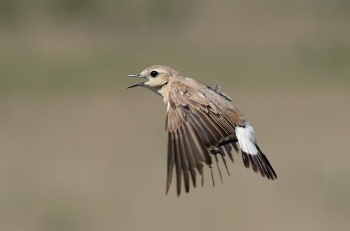(References updated) |
(Pictures of juvenile and displying adult. Behaviour expanded. Links. References updated) |
||
| Line 1: | Line 1: | ||
| − | [[Image:Isabelline_Wheatear.jpg|thumb|550px|right|Photo by {{user|Emil+Enchev|Emil Enchev}} <br />[[Bulgaria]] ]] | + | [[Image:Isabelline_Wheatear.jpg|thumb|550px|right|Photo © by {{user|Emil+Enchev|Emil Enchev}} <br />[[Bulgaria]] ]] |
;[[:Category:Oenanthe|Oenanthe]] isabellina | ;[[:Category:Oenanthe|Oenanthe]] isabellina | ||
==Identification== | ==Identification== | ||
| + | [[Image:P6241582m f.jpg|thumb|350px|right|Juvenile<br />Photo © by {{user|Cristian+Mihai|Cristian Mihai}}<br />Palazu Mic (CT), Romania, June 2018]] | ||
15-16.5 cm (6-6½ in)<br /> | 15-16.5 cm (6-6½ in)<br /> | ||
*Pale dull brown overall | *Pale dull brown overall | ||
*White rump, basal tail patches with black centre and terminal band | *White rump, basal tail patches with black centre and terminal band | ||
| − | *Pale | + | *Pale [[Topography#Wings|Axillaries]] and underwing [[Topography#General Anatomy|coverts]] |
| − | *Dark alula | + | *Dark [[Topography#Wingss|alula]] |
| − | * | + | *[[Topography#Heads|supercilium]] is whiter in front of the eye, more buff behind |
Sexes are similar | Sexes are similar | ||
| Line 13: | Line 14: | ||
Larger than an autumn-plumaged [[Northern Wheatear]] | Larger than an autumn-plumaged [[Northern Wheatear]] | ||
==Distribution== | ==Distribution== | ||
| + | [[Image:P6241294m f.jpg|thumb|350px|right|Displaying<br />Photo © by {{{user|Cristian+Mihai|Cristian Mihai}}<br />Gura Dobrogei (CT), [[Romania]], June 2018]] | ||
Southern [[Russia]] and central [[Asia]] to Northern [[Pakistan]], wintering in north-eastern [[Africa]] [[Arabia]] and [[India]]. | Southern [[Russia]] and central [[Asia]] to Northern [[Pakistan]], wintering in north-eastern [[Africa]] [[Arabia]] and [[India]]. | ||
==Taxonomy== | ==Taxonomy== | ||
| Line 18: | Line 20: | ||
==Habitat== | ==Habitat== | ||
| − | Breeds in areas or short grass or semi-desert | + | Breeds in areas or short grass or semi-desert, dry plains. |
==Behaviour== | ==Behaviour== | ||
====Diet==== | ====Diet==== | ||
| − | + | Their diet consists of invertebrates (small insects), beetles and ants; in addition to some vegetable matter. | |
====Breeding==== | ====Breeding==== | ||
They nest in a rodent burrows. | They nest in a rodent burrows. | ||
==References== | ==References== | ||
| − | #{{Ref-Clements6thAug17}}# | + | #{{Ref-Clements6thAug17}}#Handbook of the Birds of the World Alive (retrieved June 2018) |
#Birdwatchers Pocket Guide ISBN 1-85732-804-3 | #Birdwatchers Pocket Guide ISBN 1-85732-804-3 | ||
#Collins Bird Guide ISBN 0 00 219728 6 | #Collins Bird Guide ISBN 0 00 219728 6 | ||
| + | #Wikipedia | ||
| + | {{ref}} | ||
==External Links== | ==External Links== | ||
{{GSearch|Oenanthe+isabellina}} | {{GSearch|Oenanthe+isabellina}} | ||
Revision as of 16:43, 26 June 2018
- Oenanthe isabellina
Identification
15-16.5 cm (6-6½ in)
- Pale dull brown overall
- White rump, basal tail patches with black centre and terminal band
- Pale Axillaries and underwing coverts
- Dark alula
- supercilium is whiter in front of the eye, more buff behind
Sexes are similar
Confusion Species
Larger than an autumn-plumaged Northern Wheatear
Distribution
Southern Russia and central Asia to Northern Pakistan, wintering in north-eastern Africa Arabia and India.
Taxonomy
This is a monotypic species[1].
Habitat
Breeds in areas or short grass or semi-desert, dry plains.
Behaviour
Diet
Their diet consists of invertebrates (small insects), beetles and ants; in addition to some vegetable matter.
Breeding
They nest in a rodent burrows.
References
- Clements, J. F., T. S. Schulenberg, M. J. Iliff, D. Roberson, T. A. Fredericks, B. L. Sullivan, and C. L. Wood. 2017. The eBird/Clements checklist of birds of the world: v2017, with updates to August 2017. Downloaded from http://www.birds.cornell.edu/clementschecklist/download/
- Handbook of the Birds of the World Alive (retrieved June 2018)
- Birdwatchers Pocket Guide ISBN 1-85732-804-3
- Collins Bird Guide ISBN 0 00 219728 6
- Wikipedia
Recommended Citation
- BirdForum Opus contributors. (2024) Isabelline Wheatear. In: BirdForum, the forum for wild birds and birding. Retrieved 5 May 2024 from https://www.birdforum.net/opus/Isabelline_Wheatear
External Links






